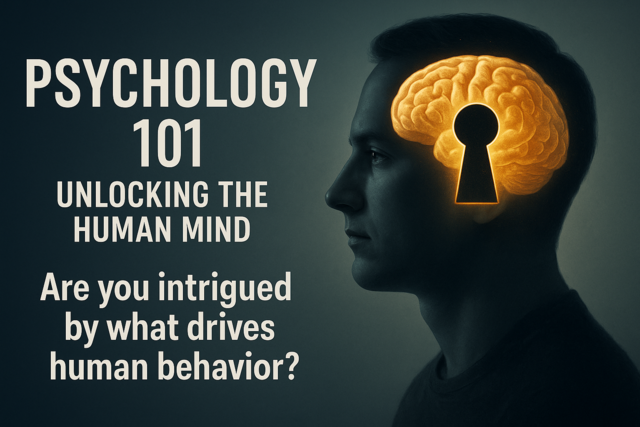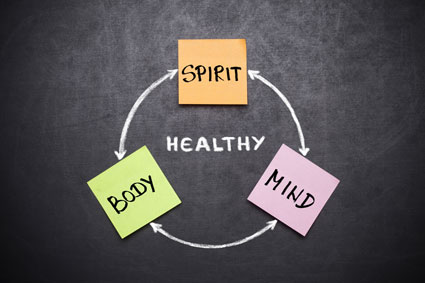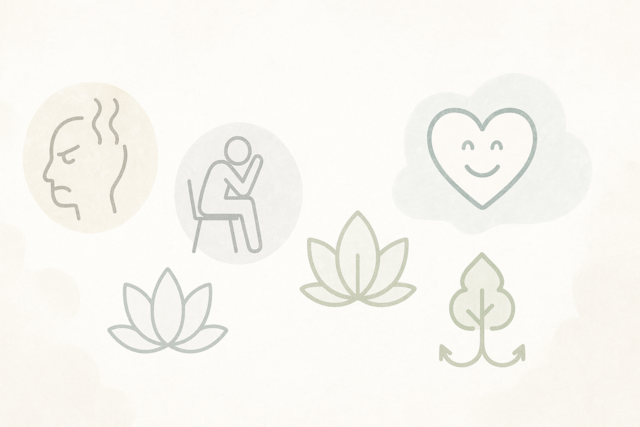Being mentally healthy has a physical component, as well. After all, your central nervous system (CNS) is the core physical operating system of the body, and your brain is the center of the CNS.
Physiological and psychological research has shown the human brain cannot tell the difference between actual occurrences and what it thinks occurred. In other words, people are capable of "creating their own reality" in their minds.
Major James Nesmeth, a prisoner of war in Vietnam, is a prime example of this. Nesmeth spent seven years as a POW, held in an inhumanely small cage in virtual isolation. After a few months in captivity, Nesmeth realized he had to find a way to occupy his thoughts or he'd go mad. He enjoyed golf, so he began to play his favorite course in his mind.
He didn't just run his mind quickly through the experience – he literally played an entire 18 holes, taking as much time in his mind as he would if he were actually on the course. His "mental golf" was fully immersive, complete with choosing his wardrobe, going to the course, imagining the weather, smelling the scents of grass and outdoors, feeling breeze or sunshine or rain, choosing and holding the proper club, making the shot, and improving his game shot by shot as he analyzed his swing. Hour after hour, day after day, Nesmeth played golf in his mind while his body grew weaker from imprisonment. Regardless of his circumstances, he kept his mind on his golf game.
When Nesmeth was released, he went home and played the course he'd played in his mind so many times. (Remember, not only had he not held a golf club in seven years, he'd been subjected to poor nutrition and confinement for most of that time, as well.) His first game, he shot 20 strokes below his previous score of 94.
Focusing on something intently in order to affect change is known as visualization. The fact that we humans are able to able to change ourselves with this mental tool is both good and bad. Like Maj. Nesmeth, this tool can be used to improve ourselves. It can also be used for self-sabotage, depending on your focus.
While visualization may seem the same as positive thinking, it does differ significantly. Positive thinking often winds up being the gold paint on a statue made of dog poop – it might look like a lovely golden statue, but it's really just a molded pile of something no one wants, coated with a thin layer of camouflage in an attempt to pass it off as something desirable. So it is with positive thinking mantras that don't inspire. (Remember "Serenity now!"?) Proper visualization is fully involved, detailed, goal-oriented, and purposeful.
Let's discuss a stumbling block many people face, and how to turn it into a psychological tool: the self-fulfilling prophecy.
Self-fulfilling Prophecies
Most people have heard the term "self-fulfilling prophecy," but many are unaware it is not just a colloquial term, it is an actual psychological phenomenon. As you might imagine, this can be useful or destructive, depending on how it's used.
A self-fulfilling prophecy occurs when we make a prediction, and by doing so, cause the prediction to come true. By stating the prediction to begin with, we set in motion direct and indirect influences, which cause us to get what we predicted.
It may sound a bit like "magic," but whether we realize it or not, we do put off energy based on our mental state. If we are in an angry mood, for example, our energy, facial expression, and body language will communicate our unhappiness and cause others to either avoid us or treat us unkindly. Our belief (in this case, anger) influences our actions (angry facial expression).
A life-affecting example of a self-fulfilling prophecy belongs to Luke, whose self-fulfilling prophecy began in childhood. Raised by his rather selfish mother (with occasional visits from his abusive alcoholic father), he observed his mother treating him and his siblings as "second best," reserving the best of everything for herself and giving her children whatever was left over. The earliest, most vivid example, in Luke's mind, was of his mother baking cookies and giving any that became burnt on the bottom to the kids, reserving the best cookies for herself and other adults. He specifically remembered how she'd put the burnt cookies on a plate, set it on the table, and say, "Here you go, kids!" as though she was giving them a special treat. Luke saw it as a cover for treating her children as second-class.
His early exposure to this snub put Luke on high alert for other slights by anyone. He was adamant he would not be treated like "second class." His hypersensitivity to being treated like second class led Luke to see slights and disrespect where none existed. His aggressive, angry attitude, which he saw as self-protection, manifested as a demeanor others perceived as uncouth and low-class. Consequently, people would treat Luke with disdain, which only "proved" to Luke that he'd been right all along – people were going to treat him like second-class, so he had to protect himself. This confirmation further fed his defensive attitude, which brought about more negative feedback, which proved Luke's original prediction further. (If Luke began to understand how his prediction is affecting his behavior, he could certainly change his life experience. Believe it or not, some people actually enjoy misery!)
As you may have guessed, if one can predict negative feedback, one can actually use self-fulfilling prophecies to create positive life experiences. Let's imagine Luke has learned about self-fulfilling prophecy and decides to give it a try. He exchanges his prediction of "everyone tries to treat me like second-class" for "I am intelligent and well-received by others." Luke stands up straighter, walks with more purpose, and smiles at others. At first, Luke may not have much faith in this process, and may revert back to his old prediction. But as he continues to restate his new prediction, he finds he is being treated with more respect by others. His friends begin to comment on how good he looks lately and gradually stop making Luke the butt of their jokes. Eventually, Luke feels confident enough that when he goes out to dinner one night and is served a poorly-made meal, he doesn't take it as a sign of disrespect directed at him. Instead of becoming angry (as he would have before), Luke politely but firmly sends the meal back and asks for a replacement. The server apologizes and returns quickly with the replacement meal, and offers Luke a complimentary dessert following the meal to make up for the delay. What a difference a change in belief makes! By changing your prediction, you can literally change your life.
Catastrophizing and Awfulizing
Catastrophizing is a primarily mental exercise, where one takes a situation or circumstance and either imagines things are worse than they are, or engages in future-thinking with the focus on all the "bad" things that could possibly go wrong. Awfulizing is the act of mentally creating the "worst case scenario" for any situation (blowing things out of proportion). As you may imagine, neither of these activities is good for your mental health!
Physiological and psychological studies have shown the human brain does not know the difference between what actually happened and what it thinks happened. Most people think of the brain as a computer, but unlike a regular computer, the human brain does not retain a "copy" in the background when you pull up a file (memory). Instead, the entire "file" is pulled forward when you access a memory and must be fully "re-remembered." This is why memories seem to change and degrade over time. (There are exceptions, such as "flashbulb memories," but that does not apply here.) This is also part of the reason individuals present at the same event may remember it quite differently. Like the old song, Yes, I Remember It Well -- we really don't!
If our brains don't know the difference between what we think happens and what actually happens, it stands to reason physiological effects will occur, as well. If you imagine you are going to get into a car accident on the way home from work and spend the entire drive focusing on the fear and trauma of a car accident, your body will feel the stress from the event as though it is actually happening even if it never occurs. As far as your brain is concerned, it did happen. Your heart rate increased, you felt stress, and chances are you arrived home tired and upset.
The best way to avoid catastrophizing or awfulizing is to stop it as soon as it begins. The sooner you recognize you're engaging in such thought patterns, the more quickly you'll be able to redirect your thoughts in a positive manner. Remember, your brain is an amazing creator. Use it to create what you truly desire.
"What's the worst that can happen?"
If your mind absolutely refuses to stop awfulizing something, make an honest assessment of the absolute worst-case scenario. Don't just have the thought and panic; instead, think of the scenario you fear and take the thought to a final conclusion.
Let's use the scenario of a car accident. Your initial awfulizing thought is probably along the lines of getting in a crash and having your car totaled. Instead of sitting with that fear, honestly think through the scenario. You get in a crash, then what? You have insurance, so the vehicle is covered. You have medical coverage, so you will be taken care of if injured. Your car is a good, safe vehicle, so chances are if you are hit, you will not be injured. You are a good driver, so chances are you can avoid any trouble, as long as you're paying attention. If you're in an accident and your car is indeed totaled and you wind up injured, you know you have friends and family who will help, and your employer will give you a leave of absence, if need be. So in reality, if you were to get in a car accident, the worst case scenario is still a manageable scenario, so there is no need to awfulize the situation. (This thought process works for just about any scenario.) Sounds simple, right? It is. It just takes practice.
Mental Self-Talk
Whether we're aware of it or not, our brains are processing information all the time. We all talk to ourselves – mentally, if not out loud – and the messages we give ourselves are always heard by our subconscious.
Most of us wouldn't go up to someone and say, "You are such a loser!" But many of us say things just like this, and worse, to ourselves every day. Some typical negative self-statements are:
I'm an idiot.
I can never do anything right.
Everyone else is better than I am.
I'm ugly.
I'm fat.
I'm too clumsy to play sports.
I'm funny-looking.
I hate my wardrobe/hair/looks.
I'll never get a date.
Everyone thinks I'm a loser.
No one likes me.
Replacing such self-talk with true positive statements is the best defense against negative self-talk. Again, don't "sugar-coat" things with false statements. That's practically worse than making negative mental statements to begin with! Not only are you attempting to lie to yourself, you're reinforcing the original negative thought by doing so. Instead, replace negative comments with something truthful. Examples:
I'm an idiot. – I made a mistake.
I can never do anything right. – I may not be good at [fill in the blank], but I am good at [name something you excel at].
Everyone else is better than I am. – I have my own gifts and talents.
I'm ugly. – I have a nice nose and pretty eyes.
I'm fat. – I am working on physical fitness.
I'm too clumsy to play sports. - I can improve at [activity] if I wish to. I just need some practice.
I'm funny-looking. – I dress well.
I hate my wardrobe/hair/looks. – I can change my style if I want.
I'll never get a date. – I am going to explore some local dating groups.
Everyone thinks I'm a loser. - Who cares what other people think? They don't necessarily know me, they just think they do.
No one likes me. – I have people who care about me.
These are just examples, of course. Use statements that are true for you. As with catastrophizing and awfulizing, the freer rein you give untrue thoughts, the louder they shout! Treat them like the unwelcome, lying intruders they are, enemies of your sense of self-worth.
Addiction and Recovery
Problems with drugs or alcohol can seriously interfere with mental, as well as physical, health. Aside from any damage done to the brain by the drug, itself, the addicted mindset is unhealthy. It creates a continual cycle of need, desperation, blame of self and/or others, and degradation. Addictive behavior destroys self-esteem, relationships, and lives.
There are many programs and recovery centers available to assist those with addiction issues. Twelve-step programs are available practically everywhere, and there are numerous books and forums for and about addiction and recovery. There are also medical programs available for some types of addiction. If you require assistance with addiction issues, contact your local support group or doctor. Also enlist your friends – those closest to you can be invaluable support while recovering from addiction.
It is also beneficial to remove yourself from environments that encourage you to use. This can often mean a radical change in lifestyle, particularly if those surrounding you are doing drugs, as well.
A Few Words About Physical Fitness
It's no secret physical exercise creates endorphins in the brain, which lift mood and help alleviate depression. Just as your body responds to your thoughts, your brain is affected by physical health.
Aside from endorphins, one of the best reasons to exercise for mental health is oxygen. Your brain needs oxygen to work properly, so increasing oxygen in your system with healthful exercise will actually help your brain function better!
You should, of course, consider your physical health and check with your doctor before beginning any exercise regime.





























